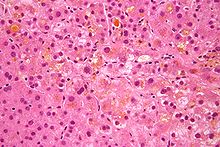User:Mr. Ibrahem/Intrahepatic cholestasis of pregnancy
| Intrahepatic cholestasis of pregnancy | |
|---|---|
| Other names | Obstetric cholestasis; cholestasis of pregnancy; jaundice of pregnancy; prurigo gravidarum[1] icterus gravidarum[2] |
 | |
| High magnification micrograph showing liver cholestasis | |
| Specialty | Obstetrics |
| Symptoms | Itchy skin, no initial rash[3] |
| Complications | Baby: Premature birth, meconium aspiration syndrome, intrauterine death[3] Mother: Gallstone disease, vitamin K deficiency[2] |
| Usual onset | Third trimester[4] |
| Duration | Resolves within 2 weeks after delivery[2] |
| Risk factors | Family history, twin pregnancy[2] |
| Diagnostic method | Based on symptoms and bile acid levels[2][3] |
| Differential diagnosis | Pemphigus gestationis, prurigo of pregnancy, polymorphic eruption of pregnancy, scabies, pre-eclampsia[2] |
| Prevention | Selenium supplementation[2] |
| Treatment | Delivery at 36 to 38 weeks, ursodeoxycholic acid, antihistamines[3][2] |
| Frequency | 0.1% to 1.5% of pregnancies (Western world)[2] |
Intrahepatic cholestasis of pregnancy (ICP), also known as jaundice of pregnancy, is a skin condition of pregnancy that results in itchy skin.[3][4] Itchiness is often severe, particularly at night, and while there is typically no initial rash, skin breakdown may occur due to scratching.[5] Other symptoms may include a yellow color and right upper abdominal discomfort.[3][2] Onset is typically in the third trimester; though occasionally may occur earlier.[4]
Risk factors include genetics, with half of people having a family history, and twin pregnancy.[2] The underlying mechanism involves liver problems, known as cholestasis, as a result of high levels of hormones.[2] Diagnosis is based on symptoms and bile acid levels greater than 10 μmol/L (4.08 mcg/mL) in the blood.[2][3]
Selenium supplementation may decrease its occurrence.[2] Management may involved delivery at 36 to 38 weeks.[2] Ursodeoxycholic acid may improve outcomes.[2] Antihistamines may be used.[3] Complications for the baby may include premature birth, meconium aspiration syndrome, and intrauterine death.[3] Complications for the mother may include gallstone disease and vitamin K deficiency.[2] While it typically goes away within 2 weeks after delivery, it often recures in subsequent pregnancies.[2]
Intrahepatic cholestasis of pregnancy affects between 0.1 and 1.5% of pregnancies in much of the Western world.[2] Rates in Bolivia are around 9% and in certain populations in Chile are 28%.[2] In more commonly occurs in winter months.[2] The condition was first described by Ahlfeld in 1883.[6]
References
[edit]- ^ Rapini, Ronald P.; Bolognia, Jean L.; Jorizzo, Joseph L. (2007). Dermatology: 2-Volume Set. St. Louis: Mosby. ISBN 978-1-4160-2999-1.
- ^ a b c d e f g h i j k l m n o p q r s t u Roth, MM (1 February 2011). "Pregnancy dermatoses: diagnosis, management, and controversies". American journal of clinical dermatology. 12 (1): 25–41. doi:10.2165/11532010-000000000-00000. PMID 21110524.
- ^ a b c d e f g h i Tunzi M, Gray GR (January 2007). "Common skin conditions during pregnancy". American Family Physician. 75 (2): 211–8. PMID 17263216.
- ^ a b c Pillarisetty, Leela Sharath; Sharma, Ashish (2023). "Pregnancy Intrahepatic Cholestasis". StatPearls. StatPearls Publishing. Archived from the original on 2024-04-18. Retrieved 2024-06-17.
- ^ Saavedra, Arturo; Roh, Ellen K.; Mikailov, Anar (2023). "15. Endocrine, metabolic, and nutritiona". Fitzpatrick's Color Atlas and Synopsis of Clinical Dermatology, 9/e (9th ed.). New York: McGraw Hill Professional. p. 414. ISBN 978-1-264-27801-5. Archived from the original on 2023-12-31. Retrieved 2023-12-29.
- ^ Geenes, V; Williamson, C (7 May 2009). "Intrahepatic cholestasis of pregnancy". World journal of gastroenterology. 15 (17): 2049–66. doi:10.3748/wjg.15.2049. PMID 19418576.
{{cite journal}}: CS1 maint: unflagged free DOI (link)
